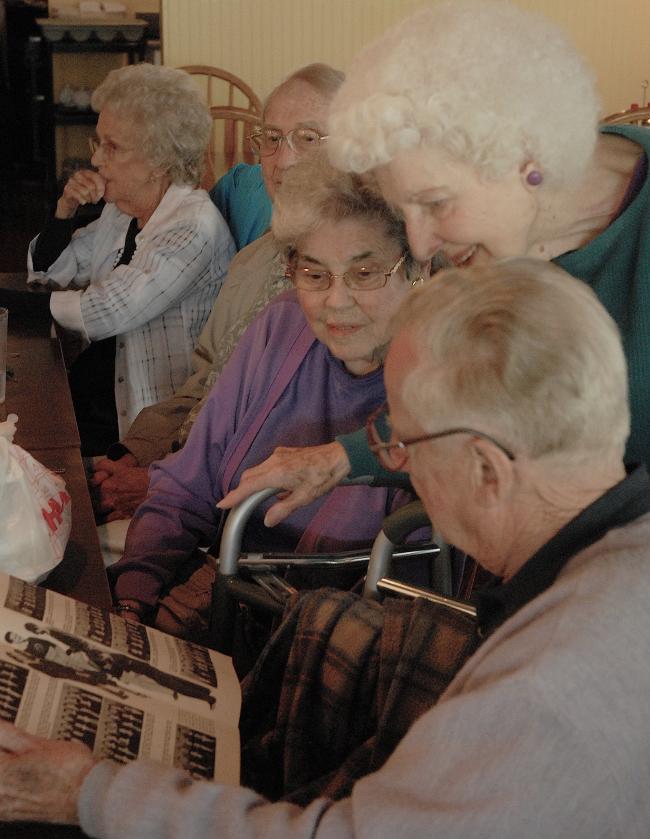WSHS Class of 1940 alumni meet regularly to reminisce
Janie Hereford Burleigh stands over Frank Ferrel to view photos of themselves in a West Seattle High School Year book, "KIMTAH 40." Betty Ferrel, purple blouse, a California native, looks on. Twelve or more WSHS alumni, Class of 1940 gather to reminisce at the Chelan Cafe monthly.
Fri, 06/19/2009
More than a dozen alumni from West Seattle High School Class of 1940 take a monthly trip down memory lane to the Chelan Café for lunch. It is Tuesday’s at 1:30 when they pull in with much to unpack; yearbooks, photos, and recollections dating back to 1928 when some shared the same first grade class at Lafayette and Highland Park elementary schools in becoming West Seattle High School “Indians.”
“There is always something new from somebody,” said Vera Bemis Hall, who stayed after school almost every night at West Seattle to play a variety of sports. She drives to the café from Kirkland and seldom misses a month. Hall attended E.C. Hughes, then Highland Park Elementary.
“The conversation can be fun, or funny, but too often it’s something that’s not,” added Hall. “We’re all getting up there. You have to expect that when you hit 87.”
Bernice Benson Link attended Lafayette Elementary with Barbara Hagquist Smith. Both sometimes sit together at the Chelan.
“One of our classmates always had money and I didn’t,” recalled Link. “We had penny candy at the store and she gave me a piece and I asked Miss Lucas, our first grade teacher, to save it for me in her desk. She thought I gave it to her and she ate it.”
“We consider ourselves ‘Indians,’” said Smith who wears her Indian pin to the lunches. She lived in the Admiral District, but moved to the Kenney Home.
“I was in civil service, chemical warfare, on the Duwamish (River) during the war,” said Smith. “I also served a year and a half in Louisiana in the WAVES.” (Women Accepted for Volunteer Emergency Service.)
She is now in charge of their 70th reunion in 2010 and made an announcement to the group that, “We better start organizing.”
Frank Ferrel and his wife Betty are regulars at the Chelan lunches. They met in Los Angeles just after the war when he was a flight dispatcher and she was a flight “hostess” for United Airlines. She is from Ontario, California. He grew up in West Seattle and started tap-dancing at Madison Middle School in the 1930s.
“Frank was the Fred Astaire of West Seattle,” chimed in Janie Hereford Burleigh, who recalled, in the presence of her husband Darrel, a 1939 WSHS grad, that the girls admired Ferrel’s thick red hair in high school.
“The chicks would leave you in the middle of the dance floor for Frank,” added an envious Bob Hallberg, a West Seattle historian with some of his Alki memories posted on the Log House Museum walls. His wife, Ada, and daughter, Tia Hallberg are also West Seattle historians.
“I lived on Alki for 80 years,” said Hallberg, whose senior moments include a plethora of crisp memories. “Ada was ‘the girl two houses away.’ We met at a little Christian Endeavor youth group at Alki Church. She thought the girl I was with was my sister and told me she never saw someone treat his sister so nice. That happened to be my girlfriend at the moment. Then Ada took over.”
Hallberg vividly recalled the indicator that school was getting close to letting out for summer.
“Our teacher would dismiss us and let us go down to Alki Beach,” he said.
"The city would have two huge clydesdale horses pull three rafts off the sand where they’d been for the winter and that was the start of the summer. They were just off the Alki Fieldhouse. (Where the Alki Bathhouse is located.) When the rafts went in the water your parents couldn’t deny you the opportunity to swim anymore. It wasn’t too cold.
“One raft was especially intriguing. It had a six feet tall tower. If you could dive off of it you were a big guy.”
Hallberg recalled getting into trouble in high school during his weeklong stint as Chinook feature editor.
“My partner and I wrote a column ‘Bunk & Stuff.’ He slipped in this double entendre, a naughty joke. We reported that other students watched a boy get a ‘tongue lashing’ from a girl, like she was disciplining him, but actually it meant they French kissed. We thought we were clear and free but one of the goodie-goodie boys on the staff told the counselor and I was demoted back to working on the press.”
Burleigh, a Morgan Junction resident who often hangs out with her husband at Tully’s on Alki to read, talked about a highlight in her life, portraying an 11 year-old girl on a KOMO-Radio soap opera in the late 1930’s for a summer.
“It was called ‘Delia and Tim’ and was sponsored by Fisher Flouring Mills,” she said with pride. “I made three dollars for the actual 15-minute show, plus a dollar-fifty for each rehearsal, a lot of money at that time. I thought it was really something. I took the bus down 35th Avenue, then jump on a streetcar on Avalon to get downtown.”
Bob Minckler was born and raised on 42nd and Finley in a little one-bedroom house.
“I didn’t know what a three-bedroom house looked like,” he said.
“My dad was a policeman,” he continued. “The city went broke, and paid him with ‘warrants,’ which were IOU’s. He’d take them down to one of the pawnshops on Yesler, and get 10 cents to the dollar. It was better than nothing. You had to live. Then came Pearl Harbor and there was plenty of work for everybody to do.”


